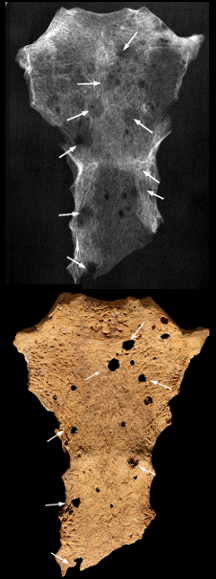Ancient ailment suggests little has changed
 British researchers have uncovered the oldest known example of human cancer, in the bones of a 3,200-year-old skeleton.
British researchers have uncovered the oldest known example of human cancer, in the bones of a 3,200-year-old skeleton.
The skeleton of the ancient male was dug up last year at an archaeological site in northern Sudan.
Analysis of the bones has revealed evidence of metastatic carcinoma throughout the body, which may have led to the death of 25 to 35 year old, who was buried in about 1200 BC.
Metastatic carcinoma originates in epithelial tissue and then spreads to other parts of the body.
It was detected in small bone lesions on the man’s skeleton using radiography and a scanning electron microscope.
Researchers determined the only likely cause was a malignant soft-tissue tumour, based on the shape of the lesions.
Subsequent imaging of the skeleton showed tumours on the collarbone, upper arms, shoulder blades and several other locations throughout the body.
The findings have now been published in the journal PLOS One.
After over 3,000 years, the exact origin of the cancer is impossible to pinpoint.
But this has not stopped the speculative minds of the research team, which has come up with a few possibilities.
Firstly, ancient houses in the region of Sudan featured hearths and bread ovens in small, poorly ventilated spaces, the kind of places that create known carcinogenic environments.
The second idea says infectious disease may have caused the man’s cancer.
Infections lead to cancer in some circumstance, including an infection called schistosomiasis which has plagued inhabitants of the region in question since at least 1500 B.C.
Schistosomiasis is caused by parasitic worms in the urinary tract or intestines, and is now recognised as a common cause of bladder cancer.
Separate research has indicated that when modern factors such as carcinogens in cigarettes, processed food, chemical factories, pollution and poor diets are removed, the base cancer rate is probably similar to the level it was in ancient times.








 Print
Print